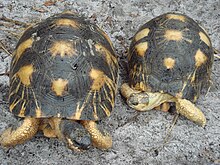Radiated tortoise
| Radiated tortoise | ||||||||||||
|---|---|---|---|---|---|---|---|---|---|---|---|---|

Radiated tortoise ( Astrochelys radiata ) |
||||||||||||
| Systematics | ||||||||||||
|
||||||||||||
| Scientific name | ||||||||||||
| Astrochelys radiata | ||||||||||||
| ( Shaw , 1802) |
The radiated tortoise ( Astrochelys radiata , Syn. : Geochelone radiata ) is an originally Madagascar endemic nature of the family of tortoise , previously the genus Geochelone has been assigned.
Appearance
With a shell length of up to 42 centimeters and a weight of 20 kilograms for males and 15 kilograms for females, the radiated tortoise is relatively large. In contrast to its sister species , the Madagascan beak- breasted turtle ( A. yniphora ), it has no bony process at the front end of the ventral shell . Characteristic of this species are the yellowish lines on a dark background that give it its name and radiate outwards on each armor segment. In very old individuals this characteristic pattern is sometimes missing. Males differ from females in that they have a concave belly armor and a longer and thicker tail.
Reproduction
The clutches of radiated tortoises comprise 2 to 12 eggs, the size of which is 36–42 × 32–39 millimeters. The hatching of the young depends on the ambient temperature and the humidity. At 25 to 27 degrees and a relative humidity of 80 percent, the young hatch after five to nine months. At an ambient temperature of 28 to 29 degrees, the time to hatch is shortened to 106 to 130 days.
distribution
The area of origin of this species is to be found in the south and southwest of Madagascar , in areas with a pronounced dry season and vegetation dominated by thorn forest . They also colonize areas with low but dense vegetation and those in which opuntia predominate after overgrazing . Accordingly, 80 to 90 percent of their diet consists of grasses ; Fruits and succulents complete the food spectrum. It is assumed that natural populations occur between the Onilahy River (south of Tulear ) and the place Antaritarika (east of Cap Saint Marie ), in a strip up to 100 kilometers wide along the coast. The main distribution area extends on the Mahafaly and Karimbola plateau.
In addition to its natural range, this species is kept for food in most regions of Madagascar as well as on the islands of Mauritius and Réunion . In addition, they are kept together with chickens and ducks, as they are supposed to offer this protection against diseases. Escaped animals can occur; established populations outside the original range are considered unlikely.
Systematics
The radiated tortoise and its sister species, the Malagasy beak-breasted tortoise , have long been assigned to the genus Geochelone . This had been called into question for a longer period of time and in 2007 these two species were (again) classified in the genus Astrochelys Gray , endemic to Madagascar and comprising only these two species , in 1873.
useful information
Radiated tortoises as food
The natural range of this species coincides with that of the tribes of the Mahafaly and Antandroy, where it is known as "Sokatra" and also as "Sokake". For these tribes, eating turtles is considered "fady", a taboo . Meanwhile, members of other tribes also live there, where turtles are on the menu, and many animals are also caught, brought to other places by truck and killed for consumption.

Danger
The IUCN lists this species as endangered. In addition to hunting, habitat destruction through deforestation, overgrazing and charcoal production is the main threat to radiated tortoises. The IUCN assumes a generation duration of 42 years. Over a period of 67 years, comprising less than two generations, this species has disappeared in 40 percent of its habitat. If the decline is extrapolated, it must be assumed that the species will be extinct in about 45 years.
See also
proof
Individual evidence
literature
- Thomad EJ Leuteritz, Trip Lamb, Jean Claude Limberaza: Distribution, status, and conservation of radiated tortoises (Geochelone radiata) in Madagascar. In: Biological Conservation. Volume 124, No. 4, 2005, pp. 451-461, doi: 10.1016 / j.biocon.2005.02.003
- Uwe Fritz, Olaf RP Bininda-Emonds: When genes meet nomenclature: Tortoise phylogeny and the shifting generic concepts of Testudo and Geochelone. In: Zoology. Volume 110, No. 4, 2007, pp. 298-307, doi: 10.1016 / j.zool.2007.02.003 .
- Manfred Rogner: Tortoises - biology, keeping, reproduction. Eugen Ulmer KG, Stuttgart 2008, ISBN 978-3-8001-5440-1 .
Web links
- Astrochelys radiata in the endangered Red List species the IUCN 2006. Posted by: Tortoise & Freshwater Turtle Specialist Group, 1996. Retrieved on 11 May, 2006.
- Astrochelys radiata in The Reptile Database
